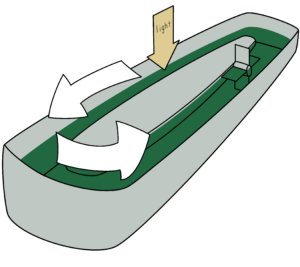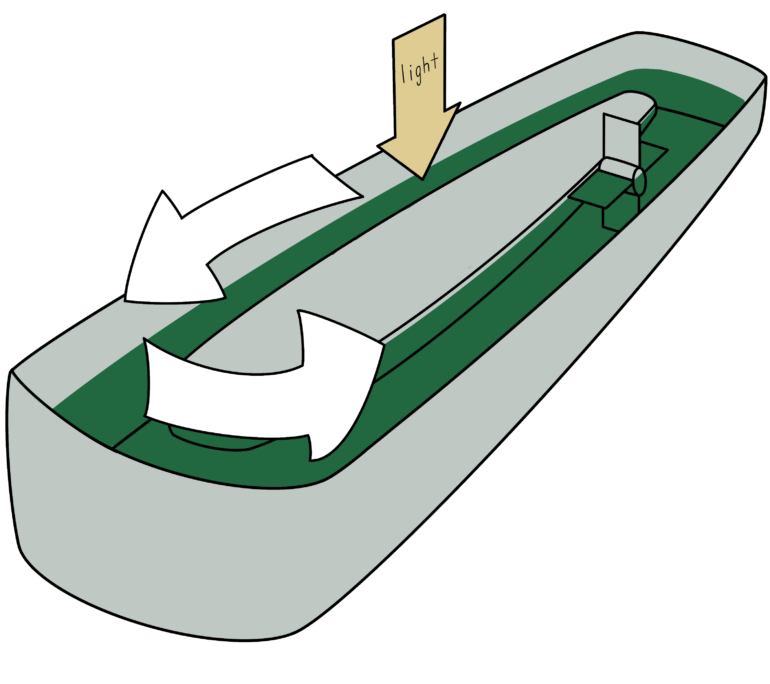Standing knee-deep in the water, you gaze at the skyline as your mind is calmed by the sound of crashing waves. The year is 2050 and you try your best to ignore the thick scent of smog that rests in the air, and instead reminisce on your time as a child, before rising water levels submerged the sand you played on. Suddenly, something slippery hooks onto your ankle, and that feeling of tranquility is suddenly replaced with disgust as you rush to remove the large piece of seaweed. Many of us fail to acknowledge that the piece of seaweed belongs to a species that can solve two of our world’s most pressing issues.
Through current media, we are constantly reminded of the threat food insecurity places upon the future of our planet. According to Natural Geographic, the Earth needs to feed two billion more people by 2050. What this really means is that if current trends in human diets remain unchanged, the world would have to grow double the current amount of crops, not only to feed the larger population but also the livestock that will need to be bred for human consumption. These numbers are concerning for a world already suffering from damages of raising livestock. Current estimates highlight that raising livestock uses up to 70% of our agricultural land and contributes to about 15% of the world’s global greenhouse gas emissions.
Another increasingly prevalent issue is the increased energy use experienced in recent years. Studies have shown that worldwide GDPs are increasing, which means that the average individual will be able to afford gas vehicles, increasing the usage of petroleum, a nonrenewable resource. Increased energy consumption requires the combustion of fossil fuels such as diesel and petroleum. Currently fossil fuel combustion accounts for 73% of green house gas emissions. With the two aforementioned problems expected to worsen in coming years, scientists are looking towards an unlikely source, algae, to save the world.
Algae in Our Food
Algae is already implemented in a significant portion of many human diets. It exists in a number of dairy products to help with fermentation. The ingredient is implemented in cereal based products like pasta, often to increase the fiber content of the dishes. However, research suggests that algae can be much more than a supplemental ingredient.
Firstly, it is important to distinguish between macroalgae and microalgae. Macroalgae are those visible to the human eye whereas microalgae are those that are too small to see without the help of a microscope. Despite its small size, microalgae is the more exciting of the two when comparing their value to human diets. Since algae do not have stems, roots, or branches, they can focus on producing proteins and fatty acids instead of cellulose.
Algae’s most impressive nutritional impact is its high protein content , which is most notably used to build and repair muscles. It contains all nine essential amino acids, those that cannot be produced within our own bodies and must be obtained through food, at similar or higher levels than crops such as soybeans and wheat. Through the five strains of amino acids tested, aspartic and glutamic acid had the highest rates of amino acid content. Aspartic acid assists both in energy production and in chemical signaling to the nervous system. Glutamine is the only amino acid that offers assistance in both muscle formation and cellular support. Through all five algae strains, the amino acid content of the nine essential acids were comparable to the rates of these acids found in soy protein.
Additionally, many forms of microalgae offer high concentration of lipids, important for signaling and cell membrane structure. This comes primarily through omega-3 fatty acids, an essential fatty acid that humans must receive from food. These fats are essential to the function of cell membrane receptors throughout the body and are involved in producing hormones that regulate blood clotting and inflammation.
There are two studies which truly highlight the importance of omega-3 fatty acids. The GISSI prevention trial, conducted in the late 1990s, focused on the effect of omega-3 fats among heart attack survivors. The group that consumed a gram capsule of omega-3 fats every day for 3 years had a reduced rate of repeat heart conditions compared to those who were given a placebo. Similarly, in the Japan EPA Lipid Intervention Study, participants who took statin (a common drug used to reduce cholesterol) along with EPA (a type of Omega-3 fatty acid) had a smaller chance of having a serious heart condition, such as a heart attack, than those who only took the statin. Additionally, omega-3 fatty acids can prevent heart conditions and stroke while also mitigating the effects of other conditions, such as lupus and eczema. Through the increased intake of protein and particular lipids such as omega-3, it is clear that algae offers much to the betterment of human health.
Still, what separates algae from our current sources of protein and omega 3-fats is its sustainability. As I mentioned earlier, soybeans are currently regarded as the best protein producing crop. However, algae is able to grow on land where other plants typically cannot grow, such as deserts using waste water, meaning that these resources can be saved for other purposes. Even in these conditions, algae can produce protein at 20 times the amount of soybeans. The dry protein mass of soybeans ranges from 35-45 percent, while algae ranges from 27-70 percent.
It may not be long until algae becomes a part of our diets. Triton Algae Innovators is a San Diego based company that has been experimenting with microalgae-based ingredients using the algae strain, Chlamydomonas. Some of the company’s most recent recipes include pastas, beverages, crostinis, and even dumplings!
Algae in Our Engines
The benefits of cultivating microalgae do not stop at its nutritional value. In recent years, biofuels have been introduced to the energy market to offer an additional form of energy to meet increased demands in an environmentally-friendly manner.
Microalgae are considered a good source for biofuel because they can grow rapidly compared to terrestrial crops, which biofuels are traditionally derived from. Most of the natural oil produced by algae is triacylglycerol, which is the ideal oil for producing biodiesel, diesel fuel procured from plants, due to its chemical similarities to non-renewable diesel. Additionally, the carbohydrates that microalgae generate can be fermented into biofuels such as ethanol and butanol. Algae biofuels have the opportunity to replace our current fuel options, and we wouldn’t even need to change our engines.
The growth of algae provides an exciting new option within the sector of biofuels. Just a single acre of algae can produce upwards of 30 times the amount of biomass as well as 60 times more oil than other land based biofuel options such as corn.
How to Grow Algae
Currently there are two major options for growing algae, the first being photobioreactors. Photobioreactors, typically shaped as a tube, are an enclosed container in which algae biomass grows. Developers hoped that through this enclosed system, evaporation would be reduced along with interaction with other algae species and predators. Photobioreactors have provided great results: A 2007 study discovered that photobioreactors can generate up to 13 times the amount of biomass as open raceway ponds, the currently more conventional method to growing algae. One microalgae farm in Iceland uses LED lights and fills the photobioreactor tube with waste water and carbon dioxide to ensure that the microalgae receives all necessary nutrients for growth. The facility has a negative carbon footprint and is able to go without herbicides, pesticides while maintaining zero waste during the production process.
The second option to grow algae is to use outdoor man made pond systems. The temperature of the pond must be maintained at around 60-80 degrees Fahrenheit with a pH of 7-9, although there are slight variations based on the type of microalgae used. The algae cannot settle at the bottom, so paddle wheels are set throughout the pond to ensure constant mixing. Typically, open pond’s are in a race car track formation (a large oval with a smaller divider in the middle) earning it the nickname of a raceway pond. This structure allows for large amounts of surface water where the algae can receive sunlight while also limiting the amount of land required.
However, there are concerning limitations to the open pond system. Since the pond has to be outdoors and exposed to sunlight, there tends to be significant amounts of evaporation experienced, thus reducing the amount of algae that can be produced. Another problem is that open ponds are exposed to bacteria and fungi predators, such as Vampirovibrio chlorellavorus which degrades algae proteins. These predators can destroy a fully functioning pond overnight.

Interview with Dr. Pomeroy
In order to further understand how microalgae can be grown and harvested, I interviewed UC San Diego professor and previous Revelle Provost Dr. Robert Pomeroy. In addition to his other commitments, he works for the California Center for Algae Biotechnology (CalCAB) and currently leads a lab where his team produces items out of algae for purchase, such as flip flops and surfboards!
When asked whether photobioreactors could be a potential option for large scale microalgae growth, he claimed that the algae produced in these bioreactors come in too small of a quantity and are too expensive to produce due to the maintenance required to keep the bioreactors functioning. Hence, Dr. Pomeroy suggested that open pond systems, due to their smaller cost, were a much more viable option to grow algae.
As Dr. Pomeroy began working with raceway ponds, he noticed that pond collapse was an increasingly prevalent issue, and he began looking into a solution. He discovered that before pond collapse would occur, whether by a predator or infection, there would be a minute change in the smell of the pond. To detect these changes, he helped develop a mass spectrometer with a sampler that can sit on the surface of raceway ponds and collect glasses. This way, it can help notify changes in the biochemistry of the air and atmosphere to help identify an infection. Normally, this method would have to be done with microscope and PCR testing and, as Dr. Pomeroy stated, “is expensive and lacks sensitivity. It could take up to two days to get results back. Meanwhile, some preliminary results for the spectrometer have come back in as quick as three hours.” He stressed that it is crucial to be immediately notified after infection because algae can be harvested at any point in production. Dr. Pomeroy explains “This is different from a majority of crops such as wheat, which you cannot harvest until it is fully grown.” Hence, one can pull the plug on the pond and harvest all the algae they have grown before all the algae is destroyed in the collapse.
Dr. Pomeroy also pointed out that his colleague, Dr. Stephen Mayfield, has been looking into other potential solutions to ensure pond success. Dr. Mayfield understands that if his team could discover a strain of algae that could grow at high pH levels and high temperatures, it would prevent predators and bacteria from infecting the pond because it wouldn’t be able to survive in those conditions. Dr. Mayfield quickly discovered that genetically engineered strains of algae could live in these extreme conditions, but due to environmental regulations within the United States, these engineered strains aren’t allowed to be grown outside. However, his team is allowed under regulations to mutate the algae to the point to which it developed into the strain type that could survive extreme conditions. To mutate algae, Dr. Mayfield and his team exposed the algae to UV light, which would damage the DNA and cause a mutation to occur. This is because the UV radiation oxidizes DNA bases, causing it to pair incorrectly during the replication process. These errors in the replication of new strands cause the development of new traits, known as mutations.
Another method for Dr. Mayfield’s team to discover an algae that could survive in extreme conditions was to selectively breed different strains of algae. Different types of algae with genetically favorable qualities could take part in sexual reproduction to produce a strain with even more advantageous qualities. This process would then be repeated till eventually a strain was developed that would be able to perfectly withstand the harsh conditions and grow quickly. Both of these aforementioned methods developed by UC San Diego researchers are pivotal in making algae a more viable food and biofuel source in the future.
But how do we harness algae’s energy as biofuel? The answer is in oils! As the algae grows in either an open raceway pond or a photobioreactor, it stores its energy as natural oils within itself. The oil is extracted by breaking down the cell structure of the algae, either through solvents or sound waves and then sent to a biorefinery to be processed. The natural oils have now become biodiesel and can be used in engines of cars, planes, and other motor vehicles.
An additional advantage to utilizing algae is its ability to play a role in carbon sequestration. Many forms of algae are photoautotrophic, meaning it requires photosynthesis to produce sugar and energy for itself. As a result of this process, algae sequesters carbon dioxide from the atmosphere. Currently, algae is less than two percent of global plant carbon but absorbs up to 50 percent of atmospheric carbon dioxide and converts it into organic carbon. As our world continues to invest more into the production of algae, we can be assured that even more atmospheric carbon would be able to be absorbed. Algae farms could be located near industrial pollution sources, such as carbon-producing refineries or power plants, and help clean the air by consuming carbon dioxide as they grow.
Our problems of food insecurity and climate change can be mitigated through the help of a plant we can’t even see. As we age and reduced resources are used for our food and less carbon is produced from our fuel, you can gaze at the sea with confidence that future generations will get to experience a beach with wide layers of sand and clean air.
Links:
https://www.nationalgeographic.com/foodfeatures/feeding-9-billion/
https://escholarship.org/uc/item/7jb0015q
https://www.ncbi.nlm.nih.gov/pmc/articles/PMC8125830/
https://www.ncbi.nlm.nih.gov/pmc/articles/PMC6893549/
https://www.frontiersin.org/articles/10.3389/fnut.2022.1029841/full
https://www.thelancet.com/journals/lancet/article/PIIS0140-6736(99)90191-5/fulltext
https://www.ncbi.nlm.nih.gov/pmc/articles/PMC3931876/
https://agsci.oregonstate.edu/sites/agscid7/files/bioenergy/education/algae_final_interactive.pdf
https://www.sciencedirect.com/topics/engineering/open-pond
https://www.sciencedirect.com/science/article/abs/pii/S2211926421000680

